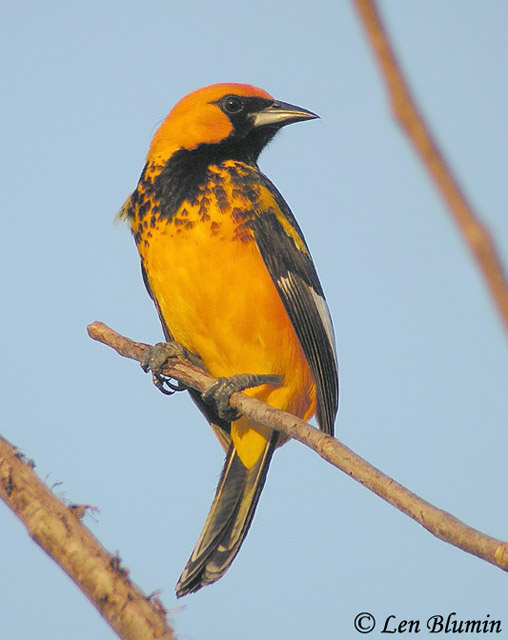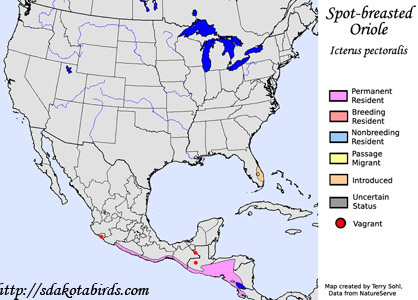| Length: 9.5 inches | Wingspan: 13 inches | Seasonality: Non-resident in South Dakota |
| ID Keys: Orange body, black throat and face mask, spots on sides of breast, black wings with bold white edges on tertials | ||
 The
Spot-breasted Oriole is a bird of Central America and southern Mexico.
However, they were accidentally introduced in southeastern Florida in the
1940s, and have established self-sustaining wild breeding populations.
Florida populations have often declined in years with harsh winters, but
populations generally have rebounded in following years. In Florida,
they are found almost exclusively in suburban areas, where landscaping of
tropical fruiting plants provides foraging opportunities. Both the
male and female Spot-breasted Oriole are very similar in overall plumage.
The
Spot-breasted Oriole is a bird of Central America and southern Mexico.
However, they were accidentally introduced in southeastern Florida in the
1940s, and have established self-sustaining wild breeding populations.
Florida populations have often declined in years with harsh winters, but
populations generally have rebounded in following years. In Florida,
they are found almost exclusively in suburban areas, where landscaping of
tropical fruiting plants provides foraging opportunities. Both the
male and female Spot-breasted Oriole are very similar in overall plumage.
Habitat: In the small introduced U.S. range in Florida, Spot-breasted Orioles are found in suburban areas with a high density of tropical landscape plants. In their native range in Central America, they are found in dry woods and thorny scrublands.
Diet: Feeds heavily on fruits and berries, as well as insects. Will also take nectar from flowers.
Behavior: Forages by moving slowly through the foliage and branches of vegetation as it searches for insects and feeds on fruit. They will also visit patches of flowers, often breaking the flowers at their base to access nectar.
Nesting: The nest of a Spot-breasted Oriole is a long pouch that hangs from the end of a tree branch, although they will also sometimes build it on shrubs or other low plants. The female alone incubates the eggs, but both parents help to feed the young after the eggs hatch.
Song: Song of the Spot-breasted Oriole is a rich series of musical whistles.
Migration: Considered a permanent resident throughout their normal range.
Interactive eBird map: Click here to access an interactive eBird map of Spot-breasted Oriole sightings
Similar Species: In introduced range in the U.S., most likely to be confused with Baltimore Oriole. However, overall they are most similar in appearance to the Hooded Oriole or Altamira Oriole.
Feeders: Will sometimes attend feeders for various fruits.
Conservation Status: Populations may be decreasing, but the IUCN still considers the Spot-breasted Oriole a species of "Least Concern".
Further Information: 1) WhatBird - Spot-breasted Oriole
2) Florida Fish and Wildlife Conservation Commission - Spot-breasted Oriole
3) Audubon Guide - Spot-breasted Oriole
Photo Information: Photo taken by Len Blumin - January 10th, 2007 - Puntarenas, Costa Rica - Photo licensed under Creative Commons Attribution NonCommerical NoDerivs 2.0 Generic license.
| Click below for a higher-resolution map |
 |
| South Dakota Status: Non-resident in South Dakota |
Additional Spot-breasted Oriole Photos (coming soon!!)
